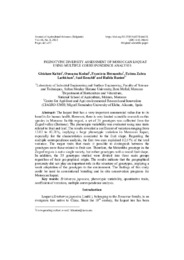Por favor, use este identificador para citar o enlazar este ítem:
https://hdl.handle.net/11000/32372Registro completo de metadatos
| Campo DC | Valor | Lengua/Idioma |
|---|---|---|
| dc.contributor.author | Hernández, Francisca | - |
| dc.contributor.author | Kabiri, Ghizlane | - |
| dc.contributor.author | Kodad, Oussama | - |
| dc.contributor.author | Zahra Lachkham, Fatima | - |
| dc.contributor.author | Ennahli, Said | - |
| dc.contributor.author | hanine, Hafida | - |
| dc.contributor.other | Departamentos de la UMH::Producción Vegetal y Microbiología | es_ES |
| dc.date.accessioned | 2024-06-28T11:01:25Z | - |
| dc.date.available | 2024-06-28T11:01:25Z | - |
| dc.date.created | 2023 | - |
| dc.identifier.citation | Journal of Agricultural Sciences (Belgrade) Vol. 68, No. 4, 2023 | es_ES |
| dc.identifier.issn | 1450-8109 | - |
| dc.identifier.issn | 2406-0968 | - |
| dc.identifier.uri | https://hdl.handle.net/11000/32372 | - |
| dc.description.abstract | The loquat fruit has a very important commercial value due to its benefits for human health. However, there is very limited scientific research on this species in Morocco. In this regard, a set of 35 genotypes was collected from the Zegzel valley (Berkane). The phenotypic variability was evaluated using nine traits related to fruit and leaf. The results revealed a coefficient of variation ranging from 13.02 to 42.21%, implying a large phenotypic variation in Moroccan loquat, especially for the characteristics associated to the fruit shape. Regarding the multiple correspondence analysis, the first two axes explained 62.57% of the total variance. The major traits that made it possible to distinguish between the genotypes were those related to fruit size. Therefore, the Mekerkba genotype in the Zegzel region is not a single variety, but rather genotypes with a round fruit shape. In addition, the 35 genotypes studied were divided into three main groups regardless of their geographical origin. The results indicate that the geographical proximity did not play an important role in the structure of genotypes, implying a weak adaptation of the genotypes to the environment. The findings of this study could be used in conventional breeding and in situ conservation programs for Moroccan loquat. | es_ES |
| dc.format | application/pdf | es_ES |
| dc.format.extent | 11 | es_ES |
| dc.language.iso | eng | es_ES |
| dc.publisher | University of Belgrade | es_ES |
| dc.rights | info:eu-repo/semantics/openAccess | es_ES |
| dc.rights.uri | http://creativecommons.org/licenses/by-nc-nd/4.0/ | * |
| dc.subject | Eriobotrya japonica | es_ES |
| dc.subject | phenotypic variability | es_ES |
| dc.subject | quantitative traits | es_ES |
| dc.subject | coefficient of variation | es_ES |
| dc.subject | multiple correspondence analysis | es_ES |
| dc.subject.other | CDU::6 - Ciencias aplicadas::63 - Agricultura. Silvicultura. Zootecnia. Caza. Pesca::634 - Horticultura. Viticultura | es_ES |
| dc.title | Phenotypic diversity assessment of moroccan loquat using multiple correspondence analysis | es_ES |
| dc.type | info:eu-repo/semantics/article | es_ES |
| dc.relation.publisherversion | https://doi.org/10.2298/JAS2304461K | es_ES |

Ver/Abrir:
1450-81092304461K.pdf
550,2 kB
Adobe PDF
Compartir:
 La licencia se describe como: Atribución-NonComercial-NoDerivada 4.0 Internacional.
La licencia se describe como: Atribución-NonComercial-NoDerivada 4.0 Internacional.
.png)